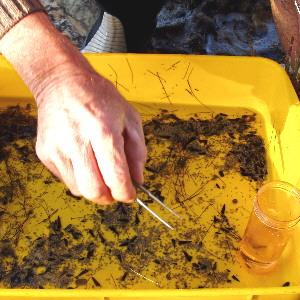
Sampling for field study of aquatic ecosystems
Semi-permanent groundwater discharge from a location in Maules Creek, in the Namoi catchment, keeps flow in the system through most droughts. The water flows downstream for approximately 8 kilometres before being lost back to the groundwater system. These waters are certainly an important groundwater dependent ecosystem (GDE) and may be a biological refuge for stygofauna. Stygofauna are a new classification of animals that live with groundwater systems including alluvial sediment and in limestone groundwater systems.
Stygofauna are generally small invertebrates, with various species of crustacean have been recorded in aquifer systems of Western Australia and New South Wales. Insects, gastropods, and worms found in groundwater systems are also considered to be stygofauna. However, little is currently known about the ecology, life-cycle and significance of stygofauna and so patterns of distribution and endemicity are not known.
GDE studies are currently in progress by the Connected Waters Initative including investigation and description of fauna and flora that make up the groundwater dependent ecosystem. The work is focused on alluvial aquifers, the hyporheic zone (ie. sediments under or beside the stream), and the riparian zone (ie. stream banks). Monitoring and sampling of key groundwater-dependent ecosystem species such as stygofauna is also in progress.
This project in funded by the Cotton CRC, and is led by Professor Acworth and Dr Martin Andersen. Key aspects of the project will benefit from collaboration with Professor Paul Adam (UNSW School of Biological and Earth Sciences), Dawit Berhane, Peter Sergov (NSW Department of Water and Energy) and Dr Brian Timms (University of Newcastle).
For more information visit Groundwater fauna (Australian Government State of the Environment report).